Movie of the Week Madness: The Horror at 37,000 Feet
I’m sure you’ll agree that William Shatner is a man apart. Still going strong at ninety-four, he appears to maintain an admirable sense of humor about himself and the ups and downs of his long career, and he seems to have come to comfortable terms with Captain James Tiberius Kirk and Sergeant T.J. Hooker, and also with his appearances on Dr. Kildare, The Twilight Zone and scads of other television shows, which, considering the highly variable quality of the medium, was undoubtedly a wise decision.
Never having met the man, this is just a guess, but I think there might be an exception to his amiable acceptance of his service record; I suspect that there’s one of his television assignments, the mention of which might well provoke a lapse into sullen silence or prompt an eruption of foul-mouthed fury: the made-for-TV movie The Horror at 37,000 Feet.
I’ve often sung the praises of the iconic ABC Movie of the Week, but old-school network television being imitative if nothing else, CBS and NBC also bombarded a supine 1970’s public with their own original TV films. As with ABC, all the usual genres were on display, and the shows ranged from the socially serious to the unashamedly schlocky; the quality level veered as wildly as a drunk trying to walk a straight line on an episode of Adam-12, and most of these films were as disposable as what is euphemistically called “bathroom tissue.”
Did the competition’s product measure up to the lofty standard set by the ABC Movie of the Week, which strained our nerves with Duel and kinked our colons with The Girl Who Came Gift-Wrapped, which chilled us with The Night Stalker and thrilled us with Killdozer (be patient, I’ll get to it eventually), which raised our consciousness with That Certain Summer and lowered it with Satan’s School for Girls? The question is so ridiculous — in so many different ways — that I won’t deign to answer it.
Or maybe I will, by submitting to the court a relevant exhibit from the early days of the triumphant second Nixon administration. Proving that disastrous blunders are as common in television as they are in politics, the bigwigs at CBS (the Tiffany of networks in those days, remember) apparently decided that if they combined two of the era’s biggest hits, Airport and The Exorcist, they would set ratings records and cover themselves with glory.
Thus it was that on the evening of Tuesday, February 13th, 1973, helpless millions found themselves trapped in their homes with The Horror at 37,000 Feet, and the execs did indeed find themselves covered with something… but it wasn’t glory.
The… um, excitement begins when a jumbo jet is chartered by wealthy American architect Alan O’Neill (The Invaders’ Roy Thinnes, who at one time sought medical help for terminal blandness, but the condition turned out to be inoperable) and his English wife Sheila (Jane Merrow, a sort of Jane Seymour from an alternate dimension where no one has ever heard of Jane Seymour). Why? They need it to take something back to the states — the remains of an ancient abbey that has been in Sheila’s family for generations. Once it’s in the US, Alan plans to reassemble it on their estate.
Also on the plane is Mrs. Pinder (Tammy Grimes, who gave her greatest performance when she sat next to Truman Capote on The Tonight Show as he said that all actors are dull-witted children). Mrs. Pinder is implacably opposed to moving the abbey for reasons that are deeply druidical, and she’s constantly muttering dark warnings of supernatural retribution. Dull-witted or not, Grimes plays Mrs. Pinder as an eyeball-rolling nut, which given the script was probably the only choice available to her.
We also have Glen Farlee (Buddy Ebsen), an imperious, bad-tempered millionaire, Annalik (France Nuyen) a famous fashion model who has so little to do that she doesn’t even rate a last name, Steve Holcomb (Will Hutchins), some sort of spaghetti western cowboy, Dr. Enkalla (Paul Winfield) a never-failing source of bland platitudes and worthless wisdom, the obligatory Cute Little Girl Traveling Alone With Only Her Dolly to Keep Her Company, and a flight crew that includes two off-the-rack stewardesses, Chuck Connors (the Rifleman himself!) as Captain Ernie Slade, and the Professor, Russell Johnson, as Jim Hawley, the plane’s navigator. Sadly, Johnson gets killed off so fast he has no opportunity to solve any problems by cobbling something together out of coconuts.
Last but not least, you have Manya (Lynn Loring), a sweaty, semi-hysterical young woman who is on the plane with both her guitar (someone always brings their guitar on a plane) and her lover… wait for it… Paul Kovalik (William Shatner), a bitter, nihilistic, alcoholic, defrocked priest! Obviously, they were determined to get their money’s worth out of Bill… or they were just terrified at what might happen if he ran out of things to play. They needn’t have worried — Shatner never fails. Even in his most restrained moments, it’s always riveting watching him give one performance while his toupee gives another.
Ok. Characters who don’t even rise to the coherence of good, solid clichés played by a collection of Brand X and Grade Z television people, all on a plane with ruins haunted by vengeful druids in the cargo hold. It could be fun… maybe. Once the situation has been set up and seats have been returned to the upright position, they only have an hour to tell the story, so at least things move quickly.
It’s not long before Captain Slade realizes that the plane is hanging stationary in the air, prevented by some mysterious force from making forward progress or changing course. Then Sheila stars hearing creepy, whispering voices as a crack appears in the floor by the galley and green slime starts oozing out it, along with smoke and weird-sounding chanting. Then loud thumps and bangs come from the cargo hold while a disheveled Mrs. Pinder utters imprecations against all unbelievers. (It’s a well-known airline proverb that once you’ve let coach passengers sneak into first class, you’ve flung open the gates of hell.)
Sheila swoons and babbles Latin despite not knowing the language while Captain Slade and Navigator Jim go back to investigate the cargo hold, where a visibly relieved Russel Johnson gets off this flight to nowhere by being instantly killed by the supernatural cold emanating from the dismantled abbey. (A stunned Captain Slade tells the others, “Jim — he’s dead!” Somewhere, DeForest Kelley was smiling.)
Through all the commotion, Shatner puts his unique spin on deathless dialogue like this (the passengers have decided that the dead druids in the hold want a sacrifice — you saw that coming, didn’t you?):
Sheila: Maybe that thing only wants me.
Paul: They’ll believe anything now that offers them the barest hope of survival, and they’ll do anything, no matter how stupid or bestial. Homo sapien in all his glory.
Sheila: Do you really hate yourself that much?
Paul: I always wait for that. The defrocked priest, delight of the armchair analyst. “Where did you lose your faith?” “I didn’t — it lost me.”
Sheila: I’m frightened — can you help me?
Paul: I’m sorry. I’m fresh out.
Sheila: Aren’t you afraid?
Paul: Of dying? I gave that up along with the rest of my illusions.
Sheila: I don’t understand you. Those are only words.
Paul: Words, yes. We talk a lot in the church. It keeps us from asking why we can’t have one sign, one tiny infinitesimal sign to sustain us in the darkness, to touch, to see.
Sheila: Father —
Paul: Don’t look to me; I have nothing. I have no help. Find your own way.
I guess Father Kovalik was out behind the seminary sampling the sacramental wine when they covered Matthew 16:4 — “A wicked and adulterous generation looks for a sign, but none will be given it except the sign of Jonah.” In any case, you can see that the theological (and literary) sophistication of The Horror at 37,000 Feet is about what you could find every week on The Flying Nun — or Scooby Doo.
Eventually, after trying to appease the ghosts in the hold by sacrificing the little girl’s doll, burning all the available wood and paper on a lounge table (Mrs. Pinder inadvertently reveals that druid bogeys don’t like fire), and deciding that the only thing to do is chuck Sheila into the hold and see what happens (it is her ancestral abbey, after all), the one-time priest takes the bulls**t by the horns and heads for the back of the plane himself. He’s already lived through a Nightmare at 20,000 Feet, so what’s seventeen thousand feet more?
As Kovalik nears the freezing area near the galley, he hears eerie, demonic voices calling his name, and at that instant, the sun appears over the horizon. (Captain Slade has been flying the plane in a steep climb to hasten this moment. How can the plane climb when it is being held immobile? Shaddap.) Manya shrieks, “Paul! We’re going to make it! Don’t go any further!”
Then, with that deathless, easily-parodied delivery we all love so much, Paul says, “No! I’ve got to see!” He continues to advance, and then he sees, through the best mist that the CBS fog machine can provide, a robed, vaguely druid-priest looking guy (who was probably back there trying to cadge some more peanuts or get an extra pillow). Kovalik screams for no apparent reason, the fuselage door pops open, and he gets sucked out; the last we see of Paul Kovalik, he’s falling through the air in a laughably inept process shot. In the battle of the damned, Druid Priest has bested Judas Priest, and I can’t say that I’m sorry.
When Manya asks, “Why did he do it?” Dr. Enkala provides a profoundly shallow epitaph for the troubled ex-priest: “Perhaps, somehow, it was a final act of faith. If there are devils, there must also be gods. I don’t know; I have no thoughts.” You’ve got to be kidding — Sister Bertrille (or Shaggy) could have done better than that. Some things end with a bang, some with a whimper; The Horror at 37,000 Feet ends with a bored shrug and an eyeball roll, but at least it ends, thank God.
As the final credits roll, the plane lands back in England (where it started — so the evil druids won. Go, druids!) The passengers (to say nothing of the viewers) heave a sigh of relief as an evening of horror comes to a close. (It’s hard to believe that it lasted only seventy-four minutes; it felt much longer.)
But has their ordeal really ended? They may think differently when they disembark in London and discover that their luggage is in Miami.
Even making proper allowances for tossed-off 1970’s TV movies, The Horror at 37,000 Feet is really, really bad; its only distinction is its awfulness, and if you’re a decent human being your main emotion watching it will probably be acute embarrassment for everyone involved — except William Shatner. As has been demonstrated time and time again, it’s impossible to be embarrassed for William Shatner; he simply won’t permit it.
Do you want to know something really horrifying? The Horror at 37,000 Feet was the sixth most-watched prime time show the week it was broadcast. I guess the CBS execs had the last laugh after all.
Terrible as this movie is, sacrificing an hour and a quarter of my life to watch it (multiple times — I have it on DVD, and you can of course see it on YouTube) has not been a completely worthless experience, because it has led me to formulate a conceptual framework that has proven useful to me, and may be helpful to you, too. I call it the Five Stages of 1970’s TV Movie Grief (or the Carl Kübler-Kolchak model, if you will.)
Stage One: Denial. “Oh my God… it can’t stay this bad. I mean, they spent money on this thing; it’s a professionally produced show on a major network. It’s sponsored by Purina! It has to get better!”
Stage Two: Anger. “Goddammit! I paid seven hundred dollars for this Motorola, and this is the best thing that’s on?! I spend three hours getting the flesh tones adjusted and the rabbit ears perfectly positioned and this is all I can watch?! Billy! Get away from there — don’t touch those rabbit ears! BILLY!!”
Stage Three: Bargaining. “Lord, if you just get me to the end of this thing, I’ll reform and live a better life; I won’t waste any more of my time watching these crappy TV movies. I’ll improve myself; I’ll read great literature… I’ll… I’ll read Anna Karenina!” (You won’t.)
Stage Four: Depression. “What’s the difference? If this is what’s on, it’s what’s on. It doesn’t matter what I watch, anyway; in a hundred years we’ll all be dead… even William Shatner.” (Don’t be so sure about that.)
Stage Five: Acceptance. “Honey, where’s the TV Guide? I want to see what’s on tonight. Oooo — Death Cruise. Eddie Albert, Tom Bosley… and Kate Jackson?! Fire up the oven and get those Swanson TV Dinners cooking — this is going to be a good one!”
Some People Never Learn
Thomas Parker is a native Southern Californian and a lifelong science fiction, fantasy, and mystery fan. When not corrupting the next generation as a fourth grade teacher, he collects Roger Corman movies, Silver Age comic books, Ace doubles, and despairing looks from his wife. His last article for us was Heroes and Humanity: Jack Kirby at the Skirball Center
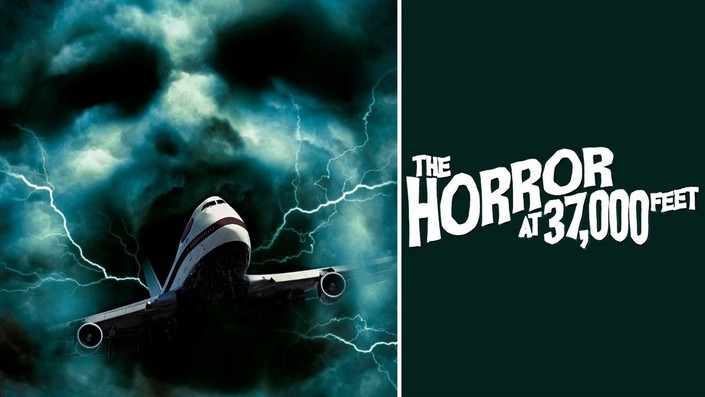
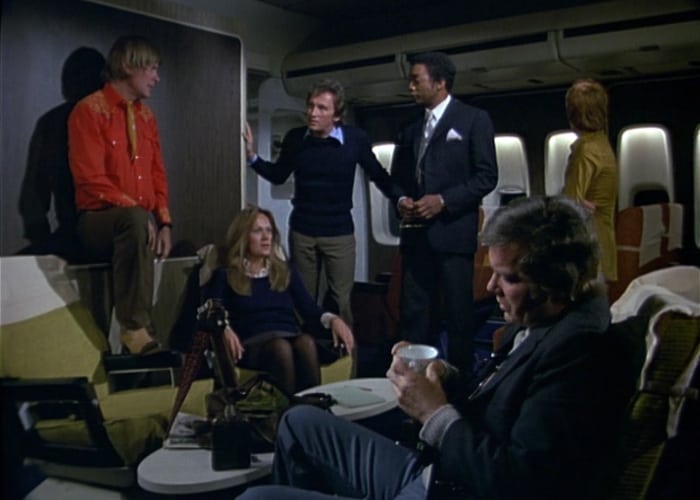
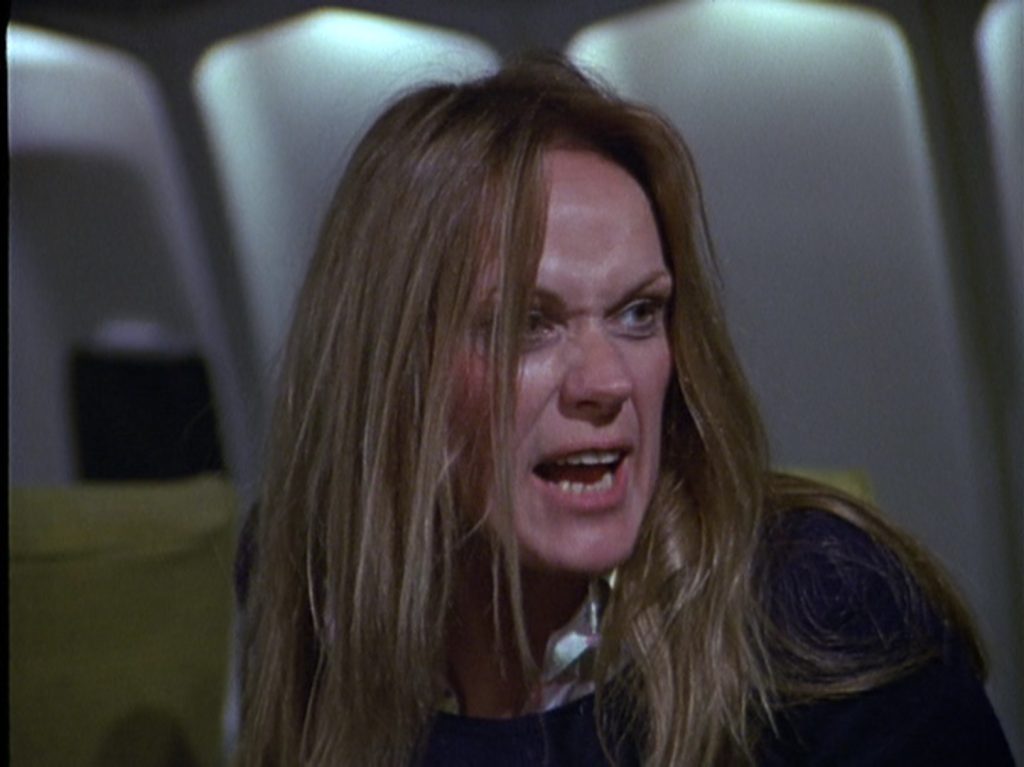
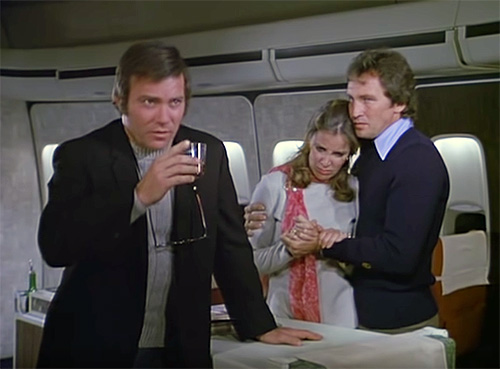

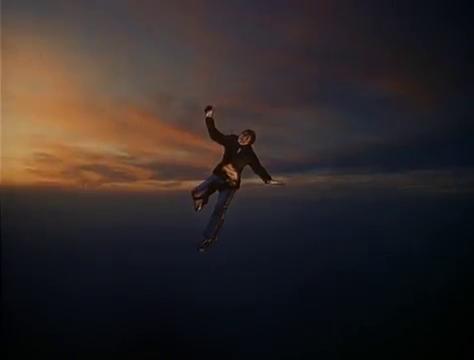
Avid TV movie watcher as a kid but I have lingering PTSD from this monstrosity. Worst thing about it was how mind numbingly boring it was and the amount of competent actors phoning it in.
How did I miss this one? And, no, Mr. Shatner does not appear to be embarrassed, if we can accept the quote from him in the Wikipedia entry for this film, in which he describes it as one of his more “unique” ways of dying:
“I get sucked out of an airplane while carrying a lit torch(!) into the airliner’s baggage compartment to try to confront a druid ghost.”
The torch is a nice touch, I admit. Not quite the black comedy of The Girl Most Likely To … (1973), which introduced the glory that is Stockard Channing to me, but certainly a unique way to go.
Shatner didn’t even mention – nor did I – the fact that on his way to meet the druids, there was one shot where he suddenly (miraculously?) was wearing his clerical collar and in the next shot it had disappeared. What do dead druids care about continuity, anyway? About as much as the people who made this movie, apparently.
And I fully intend to get around to the Joan Rivers-written The Girl Most Likely To. This is going to sound hypocritical at this point, but man – it’s a GOOD one!
I can’t wait for your review of “The Girl Most Likely To.” It made a huge impression on me in junior high, especially the ending which I still can’t believe they got away with. If any TV movie could warrant a new take this is it although it’s fine for what it was. I actually own the Blu-ray.
Your five stages of movie grief are disturbingly accurate, as you well know. 😆
Excellent movie treatment, and I bet that the dolly sacrifice scene was unexpectedly therapeutic for a lot of people. But there’s one thing that’s, erm… “bemusing” I think is the right word… one thing that’s bemusing me:
They’re… flying… the remains of an abbey… over an ocean with the intent to “reconstruct” it on the other side?
What, one of those buildings where one layer of footing stones in a small corner tends to weigh in excess of a ton? A whole ruined abbey? On a plane?
It’s a legitimate objection, but look at it this way – if that plane can lift Shatner’s ego, it can lift anything!
Oh, dear. 😆 Touché.
Those 5 stages of movie grief are spot on. They even work with television specials. For example, there is one about Star Wars that takes place at Christmastime. Believe you me.
I had the pleasure of enjoying two Easter dinners with Paul Winfield who was a friend of a friend of mine. Now I will forever regret not discussing this movie and his character motivation. All that precious time wasted discussing the film Sounder.
Paul Winfield?! That’s very cool – if only he’d been in Robot Monster…